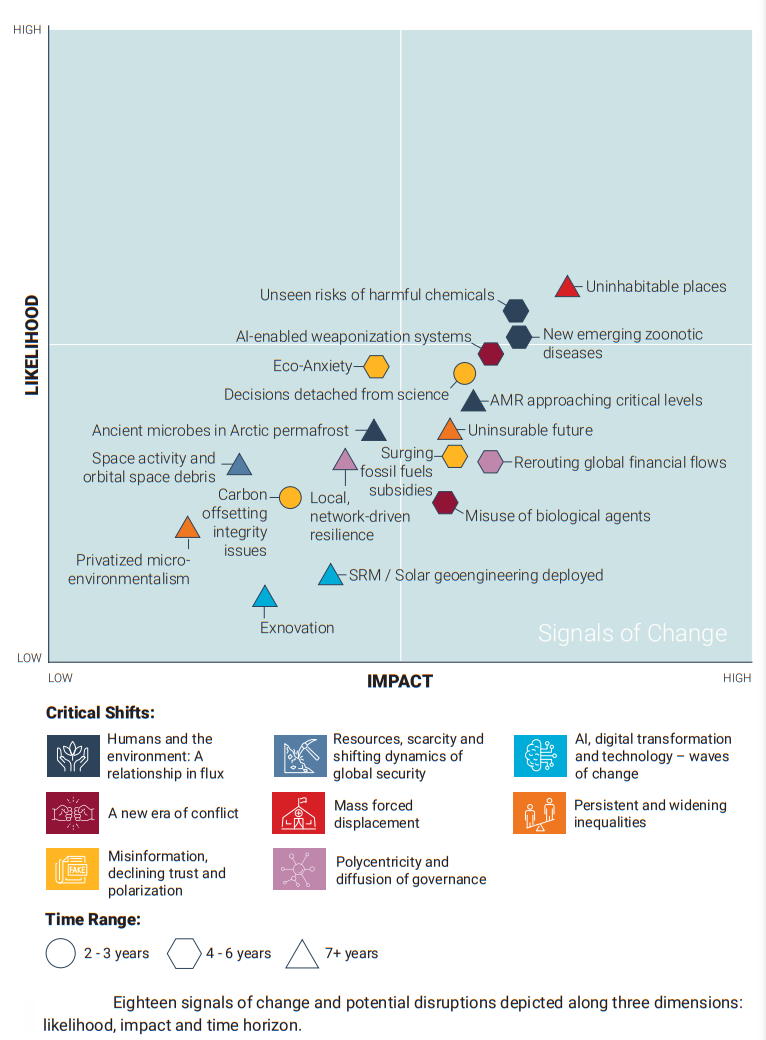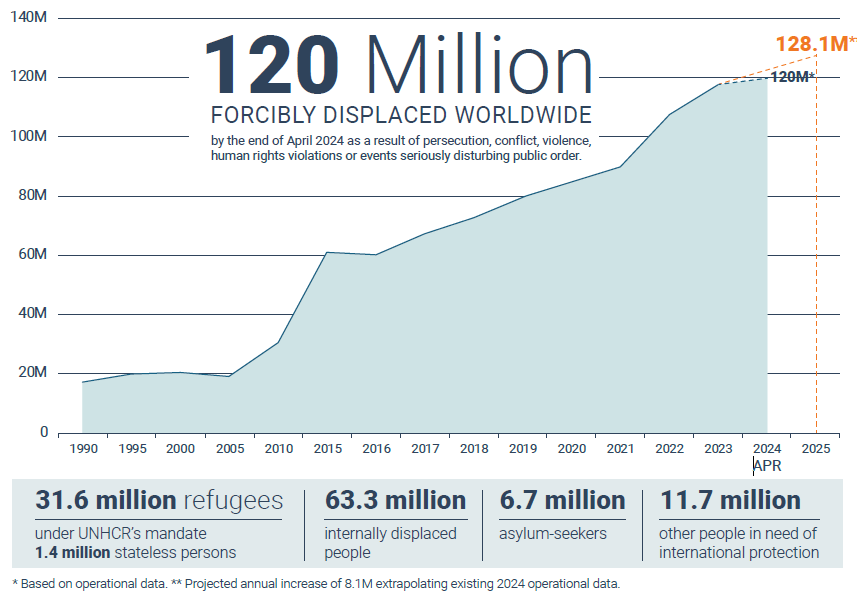Biodiversity & Environment
UNEP Foresight Report 2024
- 18 Jul 2024
- 9 min read
For Prelims: UNEP Foresight Report 2024, UN SDG Goals, United Nations, Global Warming, Forced Displacement, Climate Change, UNEP, UNEA.
For Mains: UNEP Foresight Report 2024, Highlights, Significance etc.
Why in News?
Recently, the United Nations Environment Programme (UNEP) released a report titled "Navigating New Horizons: A Global Foresight Report on Planetary Health and Human Wellbeing, 2024.
- The report urges the world to address emerging challenges that could disrupt planetary health. It highlights 8 critical global shifts accelerating the triple planetary crisis of climate change, biodiversity loss, nature loss, and pollution.
What are the Key Highlights of the Report?
- No Significant Progress in UN SDG Goals: 85% of the 169 SDG targets are off track and 37% of the targets have shown no progress or have regressed since 2015, as of the latest 2023 SDG Progress Report.
-
42.85% of the targets for SDG 6 (Clean Water and Sanitation), SDG 13 (Climate Action), SDG 14 (Life Below Water), and SDG 15 (Life on Land) are either stagnating or regressing.
- 60% of environmental indicators remain either deteriorating or unclear in their status.
-
- 8 Shifts, 18 Signals of Change: The UNEP report identified 8 critical shifts with 18 potential signals of change.
- These signals are not inherently good or bad, but are early signs of potential future developments and could have a big impact on the future if they do happen.
- Rapidly Changing Relationship Between Humans and Environment: Human activities are predicted to affect over 90% of land by 2050. Up to 46% of species may face extinction.
- Global temperatures are projected to rise 2.1-3.9°C by 2100.
- Greenhouse gas emissions, mainly from fossil fuels, are driving these changes, with developed nations responsible for most emissions.
- Scarcity and Competition for Critical Resources: The global competition for critical resources is reshaping international security. Demand outpaces supply, amplifying volatility and potential conflicts, especially in regions with concentrated reserves.
- The most fundamental resources, water and food, face growing threats from climate change and unsustainable management, disproportionately affecting vulnerable populations.
- The projected growth in demand for critical minerals in 2050 to achieve net zero emissions is given below:
- AI, Digital Transformation and Technology: The key drivers of rapid advancement of digital technologies and AI include mobile devices, internet access, and the growth of AI that offer prospects for progress, their environmental implications require consideration.
- There are over 8.89 billion mobile subscriptions, with around 5.6 billion users owning a device. As per ITU reports, 67.4% of the world's population were internet users in 2023.
- A New Era of Conflict: The report warns that AI-based and autonomous weapons could cause major global disruptions in 4-6 years without human oversight.
- Experts believe there is a high likelihood (59%) of such disruptions occurring, with a high perceived intensity of impact.
- Examples include the Ukrainian military using AI-equipped drones to strike Russian targets in the Russia-Ukraine war, and the risk of AI-controlled bioweapons.
- Mass Forced Displacement: The report reveals that 1.5% of the global population is forcibly displaced, nearly double the number from a decade ago.
- Climate change is a major driver, with extreme conditions like wildfires, flooding, poor air quality, and intolerable heat contributing significantly.
- Africa, Central America, Pacific Islands, and South Asia face higher risks of climate-induced migration and displacement.
- By 2070, 3 billion people could live outside suitable climate conditions if no mitigation occurs and environmental migrants could be 25 million-1 billion by 2050.
- Internally displaced persons have increased by 340% in 20 years, with climate-related disasters now displacing more people than conflicts.
- Widening Inequalities: The report highlighted that global inequality is worsening, with the top 10% holding over 75% of wealth, while the bottom 50% own just 2%.
- Inequality within nations is driven by unequal access to education, jobs, and services, as well as globalisation.
- Wealth inequality also leads to ecological inequities, as the wealthy drive climate change, while the poor face the greatest environmental harm.
- Misinformation, Declining Trust and Polarisation: The erosion of trust in science and public institutions has undermined evidence-based policymaking and democratic governance.
- This decline in trust, from perceived failures and 'fake news', makes it harder to implement effective policies to address challenges like the climate crisis.
What are the Future Outlook and Recommendations of UNEP?
- Broadening Stakeholder Engagement: Actively involve a diverse range of stakeholders, including women, indigenous groups, and young people, using technological and social innovations to enhance public participation, combat misinformation, and build trust.
- Stronger Voice for Young People: Ensure young people have a significant role in decision-making at all governance levels to achieve intra- and inter-generational equity.
- Redefining Progress Beyond GDP: Incorporate broader indicators of human and environmental well-being, such as the Inclusive Wealth Index and Multidimensional Vulnerability Index, to guide investments towards Sustainable Development Goals.
- Community Empowerment: Promote agile and adaptive governance that empowers communities to experiment, innovate, and share knowledge, while setting flexible long-term environmental goals and targets.
- Data-Driven Decision-Making: Leverage data, monitoring, and knowledge-sharing platforms to inform evidence-based policymaking across sectors and scales, enhancing environmental monitoring from local to global levels.
- Sustainable Prosperity: Transform economies and societies to achieve prosperity within environmental limits, guided by shared values of equity, sustainability, and resilience, and reimagine the role of businesses, markets, and governance to prioritise people and the planet.
What is UNEP?
- The UNEP is a leading global environmental authority established on 5th June 1972.
- It sets the global environmental agenda, promotes sustainable development within the United Nations system, and serves as an authoritative advocate for global environment protection.
- Major Reports: Emission Gap Report, Adaptation Gap Report, Global Environment Outlook, Frontiers, Invest into Healthy Planet.
- Major Campaigns: Beat Pollution, UN75, World Environment Day, Wild for Life.
- Headquarters: Nairobi, Kenya.
|
Drishti Mains Question: How has the evolving human-environment relationship impacted global SDG progress? Analyse the implications of this relationship for global progress and propose innovative strategies for a sustainable future. |
UPSC Civil Services Examination Previous Year Question
Prelims
Q. The ‘Common Carbon Metric’, supported by UNEP, has been developed for
(a) assessing the carbon footprint of building operations around the world
(b) enabling commercial fanning entities around the world to enter carbon emission trading
(c) enabling governments to assess the overall carbon footprint caused by their countries
(d) assessing the overall carbon foot-print caused by the use of fossil fuels by the world in a unit time
Ans: (a)
Mains
Q. Discuss global warming and mention its effects on the global climate. Explain the control measures to bring down the level of greenhouse gases which cause global warming, in the light of the Kyoto Protocol, 1997. (2022)










